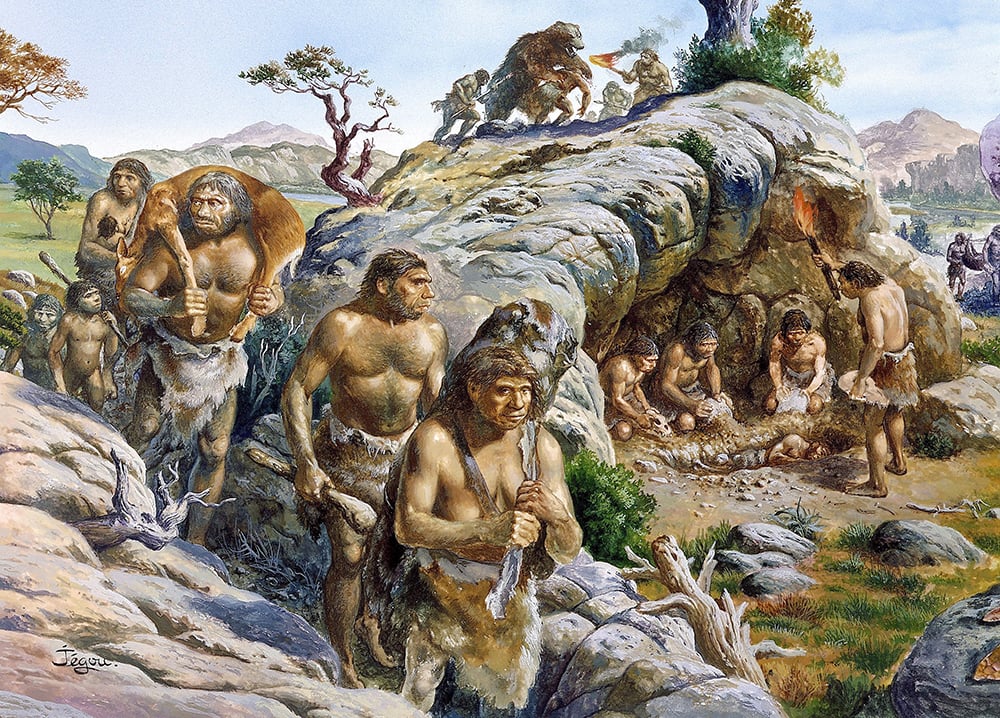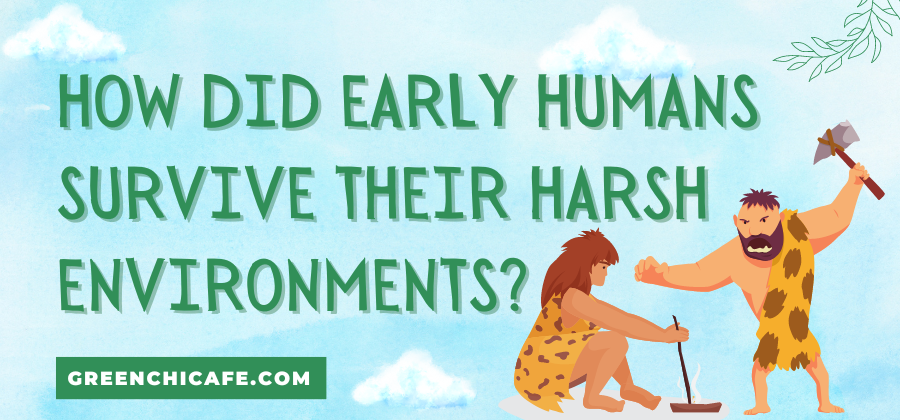Early humans faced severe climatic challenges and scarcity, yet managed to persist and spread due to adaptive intellect and resourcefulness.
Understanding our ancestors’ survival strategies reveals inspirational lessons on perseverance.
From the first humans to early Homo sapiens, environmental pressures were selected for advantageous traits enabling endurance through ice ages, droughts, and variable climates.
How Did Early Humans Survive Their Harsh Environments?

Early humans survived and spread despite severe climates and scarcity by evolving intellect, inventiveness, and adaptability.
Their creative problem-solving led to tools, clothing, fire, and shelters enabling persistence through ice ages, droughts, and variable conditions.
Key Points
- Humans developed hunting, gathering, fishing, and food storage strategies against shortages.
- They crafted specialized clothing, housing, and heating adaptations suited to cold climates.
- Genetic and behavioral evolution increased intellect and resilience over eras.
What Major Problems Did Early Humans Face Because of the Environment?
Extreme shifts between ice ages and warmer periods posed challenges for early humans before technology.
Habitat destruction, scarce resources, rival species, and uncontrolled fire also threatened survival.
Humans lacked the advantages of strength, speed, or natural weapons.
But environmental pressures bring forth adaptations.
These pressures evolved human intellect, inventiveness, and skills to craft tools, clothing, and shelters against the elements, predators, and food shortages.
How Did the Early Humans Keep Themselves Warm in the Winter?

Before the fire, humans endured ice ages through animal hide clothing, fur bedding, huddling in dark caves or rock shelters, and migrating to warmer regions when possible.
Fire later enabled the heating of primitive dwellings.
Insulating grass and mud structures also emerged.
Rendered animal fat provided calories and body fuel for generating heat.
Thermal-conserving physiology like shorter limbs prevented heat loss as humans radiated out of Africa into colder regions.
What Major Dietary Changes Helped Early Humans Survive?
Hunting and eating meat brought calories and nutrients sustaining larger brains and spreading into new environments lower in edible plants.
Better digestion, stone tools, and coordinated hunting enabled exploiting new food sources.
Cooking meat later increased digestibility and safety.
Foraging, fishing, targeted seasonal migrations, and gathering nuts and wild grains also expanded viable diets to supplement sporadic hunting.
How Did Humans’ Brains Evolve to Aid Survival?
Increasingly complex language, memory, and innovative thinking gave early humans an advantage in finding food, navigating harsh conditions, and responding to seasons and danger.
Higher intellect fostered the invention of shelters, clothing, and weapons.
Teaching successive generations survival skills accumulated knowledge across eras.
Intelligence and communal bonds enabled humans to spread despite hostile habitats and predators through behavioral adaptations.
What Genetic Adaptations Helped Early Humans Thrive?
Beneficial genetic mutations allowed digestion of new foods, conserving heat, moderate thirst, resisting novel parasites, and breathing at high altitudes.
Darker skin prevented sunburn nearer the equator.
Lactose tolerance arose with animal domestication for calories.
Natural selection favored mutations enhancing survival and reproduction in a given environment.
Accumulated adaptations gradually differentiated isolated populations across Africa and Eurasia over eras.
How Did Migration Help Early Humans Overcome Local Conditions?
When local carrying capacity was exceeded or climate shifted dramatically, migrating allowed pursuing resources elsewhere and escaping harsh changes in situ.
Flexible habitation enabled diffusion into new lands for hunting, foraging, and gathering new foods and materials.
Ancestral humans followed animal migrations and blooming vegetation.
Gradually, migration pathways took early humans into new continents and hemispheres.
The movement was key to overcoming adverse localized scenarios.
How did Early Humans Survive in Their Environment?
Early humans survived harsh environments by evolving physical and behavioral adaptations over thousands of generations.
They developed stone tools, clothing, and control of fire to persist through ice ages, temperature extremes, droughts, and threats from predators and rivals.
Communal living, communication, and cumulative knowledge transmission also aided survival.
Gradual genetic changes gave favorable traits like the digestion of new foods, thermoregulation, and disease resistance through natural selection pressures.
Persistence in challenging settings was key to human ancestors spreading from Africa worldwide.
How did Early Humans Survive the Ice Age?
Early humans survived brutal ice ages through innovations like animal hide clothing, cave shelters with fire, fat-rich diets, and seasonal migration to warmer refuges.
They made specialized tools like scrapers, awls, and spear points from animal bones and stones to craft garments and hunt effectively.
Groups sharing food, childcare, and knowledge further increased resilience.
Generationally improving shelter-building, fire-making, and hunting and foraging equipment and strategies allowed humans to spread into new subarctic environments despite the cold.
What Major Problems Did Early Humans Face Because of the Environment?
The environment posed threats including habitat destruction from disasters, scarce food and water resources, extreme weather shifts between ice ages and warmer periods, uncontrolled fires, dangerous predatory species, and competition from emerging rival hominid species.
Early humans lacked the advantages of strength, speed, or natural defensive weapons, forcing innovative adaptations through intellect, resourcefulness, and communal cooperation to ensure survival despite harsh challenges.
Key Takeaways:
- Early humans triumphed over environmental instability by adapting intellectually and genetically over millennia.
- Our ancestors developed innovative tools, social strategies, and physical traits through necessity, ultimately spreading worldwide despite harsh beginnings.
- Their perseverance remains inspiring today.
FAQ
How Long Have Humans Been on Earth?
Evidence indicates archaic Homo sapiens emerged over 500,000 years ago in Africa based on fossil records. Anatomically modern humans arose around 300,000 years ago and migrated worldwide 40,000 years ago.
What Environmental Factors Influenced Human Evolution?
Climate fluctuations, ice ages, droughts, disasters, and habitat variability are selected for advantageous genetic and behavioral adaptions enhancing survival and reproduction. Competition and scarcity also drove innovation.
How Did Fire Help Early Humans Survive?
Fire provided heating, light, cooking, protection from predators, and a means to create advanced tools through smelting and crafts. Fire-based adaptations profoundly aided human survival and advancement.
What Food Sources Sustained Early Humans?
Hunting, fishing, foraging, gathering wild grains and fruits, scavenging, and eventually early agriculture provided nourishment. Meat obtained through hunting and scavenging was a critical high-calorie food source.
At GreenChiCafe, we are passionate about protecting the natural world and sharing knowledge that cultivates more sustainable lifestyles.
Please check out our website for more content about caring for our planet and living eco-consciously.
